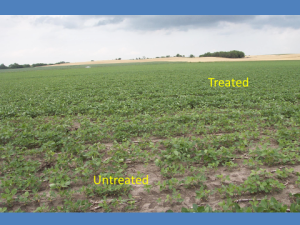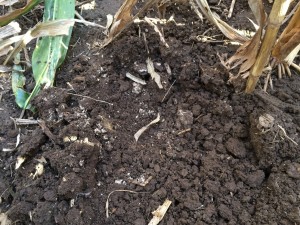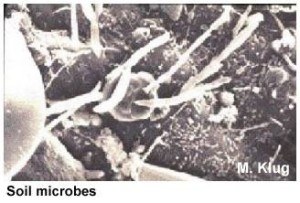Gypsum contains about 22% calcium and since soil pH has little effect on its solubility, it is a good source of calcium in high pH soils. Calcium in high pH soils often is fixed as calcium carbonate. Managing alkaline soil pH is best done by maintaining high levels of free calcium in the soil. This is why gypsum is added to soils with high soil pH (>8.0). Gypsum is an excellent and inexpensive source of soluble calcium.
Calcium is often overlooked as a crop nutrient. Most soil fertility specialists assume that so long as your soil pH is sufficient that you will have adequate calcium nutrition. This is only partly correct.
We should first consider the importance that calcium plays in the plant. Calcium is sometimes called “the trucker of all nutrients”. This is because calcium improves the absorption of all nutrients and helps in their translocation within the plant. Calcium helps neutralize organic acids in plants that form during cell metabolism, therefore helping maintain proper pH. Calcium activates several enzyme systems that serve as plant growth regulators. Calcium helps convert nitrate-nitrogen into ammonium forms of nitrogen needed for protein formation. Calcium is critical for normal cell division and for strong cell walls. Also very important is that calcium improves disease resistance in plants. Lastly calcium improves water use efficiency by plants.
Calcium Improves Water Efficiency
Nutrients can play a key role in improving plant water efficiency. Calcium is most important for water efficiency because:
- Calcium and calmodulin (calcium modulated protein) act as a messenger molecule to jump start plant protection devices.
- Calcium helps stabilize plasma membranes and decreases hydrogen peroxide concentrations which increase with drought stress. This maximizes cell water content.
- Calcium is vitally important for root hair growth increasing root surface area significantly increasing water uptake.
- Calcium works with abscisic acid (formed especially when under drought stress) to increase water conductivity within the plant.
- Calcium is involved with the closing and opening of the stomata decreasing transpiration losses.
- Calcium improves cell wall thickness and reduces cuticle breaks where water can be lost from the leaf.
In the soil, calcium works with microbial populations to improve decomposition of organic matter and crop residue to convert to plant available nutrients. It also enhances nitrogen-fixing bacteria in the soil so that more nodules are formed on legume roots increasing the amount of nitrogen produced. Obviously, calcium plays a key role in plants and soil.
Factors that can affect calcium availability from the soil is the balance with other nutrients. If calcium is low because you have an imbalance with magnesium, potassium, sodium, aluminum or hydrogen, your plants may be stressed. If pH is low, you may encounter an imbalance with hydrogen and aluminum (particularly pH< 5.3). If your soils have been heavily manured or received high amounts of lagoon water you may have an imbalance with potassium and possibly magnesium. In some soils you may have high magnesium levels due to the soil’s parent material (or soil erosion) that can cause an imbalance with calcium. These soils will be stickier and less friable decreasing root development and nutrient uptake. They also have slower water infiltration, which will also reduce water efficiency.
Another factor that can affect calcium availability is high levels of carbonates and bicarbonates in the soil. This will be related to high sodium levels and/or high pH levels in the soil. Irrigation water can also contain high levels of carbonates and bicarbonates. Carbonates and bicarbonates will react with calcium making this calcium less available for plant uptake. This calcium will probably appear on the soil test as exchangeable calcium, but in reality is not plant available. This is why some high pH soils may actually be low in calcium availability. Acid reactions in the soil that acidify this calcium carbonate will make the calcium available.
Most common sources of calcium for agricultural crops include calcium carbonate (limestone) and calcium sulfate (gypsum). Both are good sources of calcium as long as they have small particle size and applied in the correct soil conditions. Limestone is most effective as a calcium source in low pH soils where it will be reactive. It is not a good calcium source in high pH soils since it won’t be soluble. Gypsum is a soluble form of calcium at all soil pH levels.
 Gypsum has been used for centuries to reclaim sodium affected soils (alkali soils). It is effective since it has good solubility regardless of soil pH. In fact, its solubility is enhanced in sodic soils. Some data would suggest that the solubility of gypsum in alkali soils is four times greater. Once the gypsum dissociates into calcium and sulfur the calcium has the greatest attraction for the soil particle displacing sodium. The calcium will help flocculate (aggregate) the soil whereas the sodium on the soil causes dispersion. This means that calcium from the gypsum will improve soil structure and improve plant growth.
Gypsum has been used for centuries to reclaim sodium affected soils (alkali soils). It is effective since it has good solubility regardless of soil pH. In fact, its solubility is enhanced in sodic soils. Some data would suggest that the solubility of gypsum in alkali soils is four times greater. Once the gypsum dissociates into calcium and sulfur the calcium has the greatest attraction for the soil particle displacing sodium. The calcium will help flocculate (aggregate) the soil whereas the sodium on the soil causes dispersion. This means that calcium from the gypsum will improve soil structure and improve plant growth.


